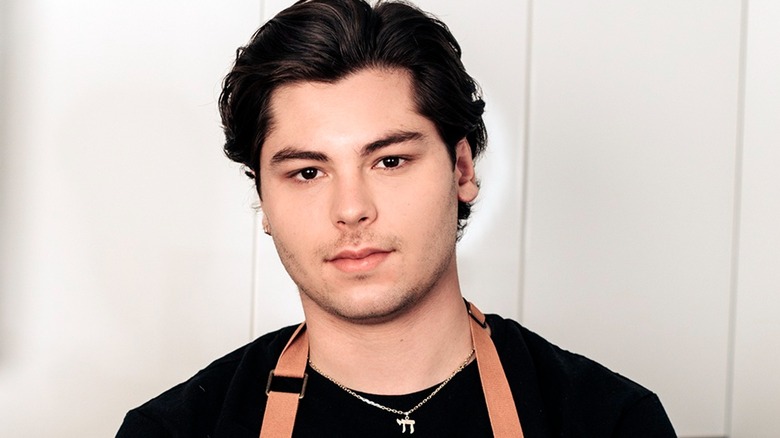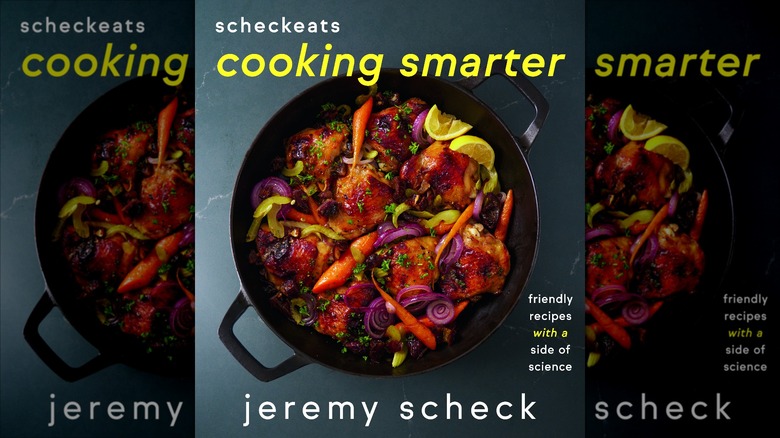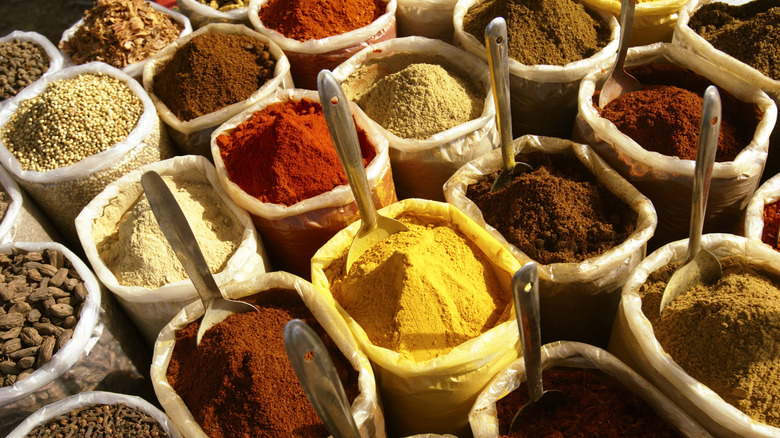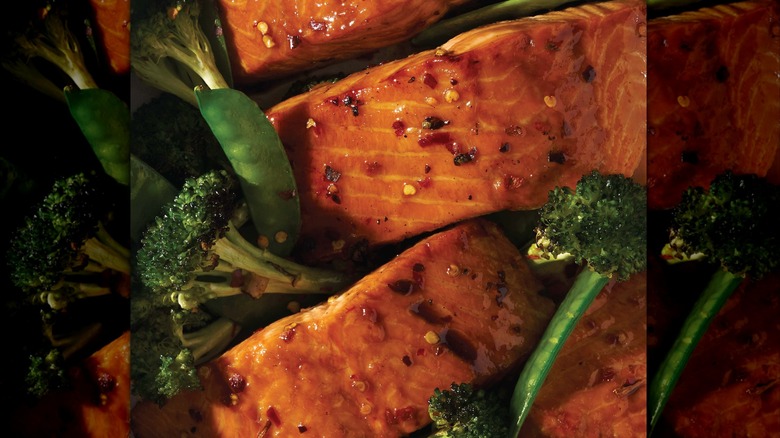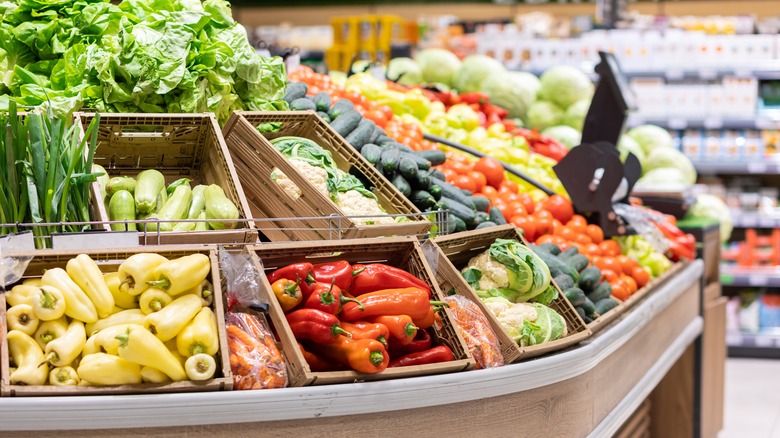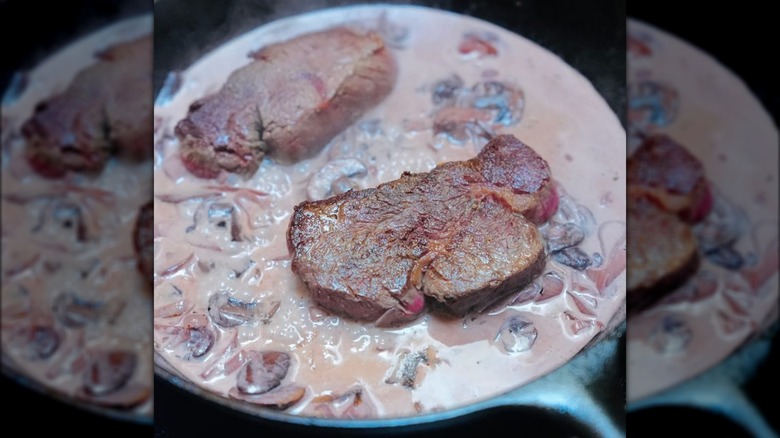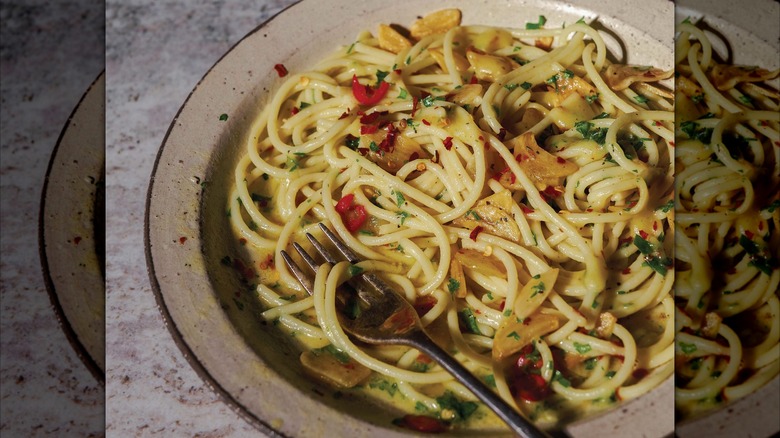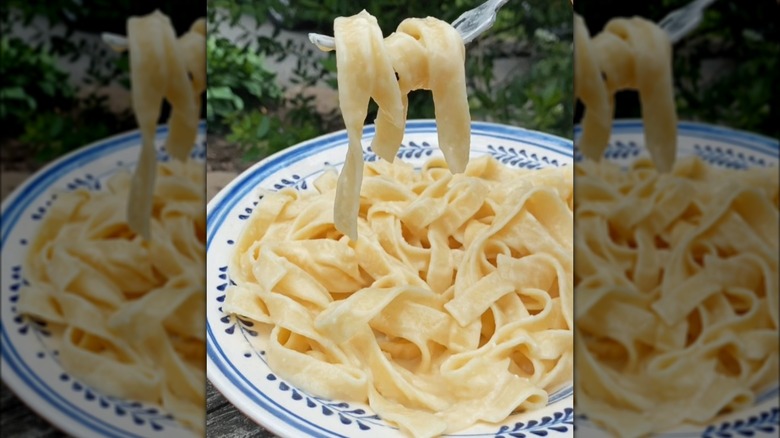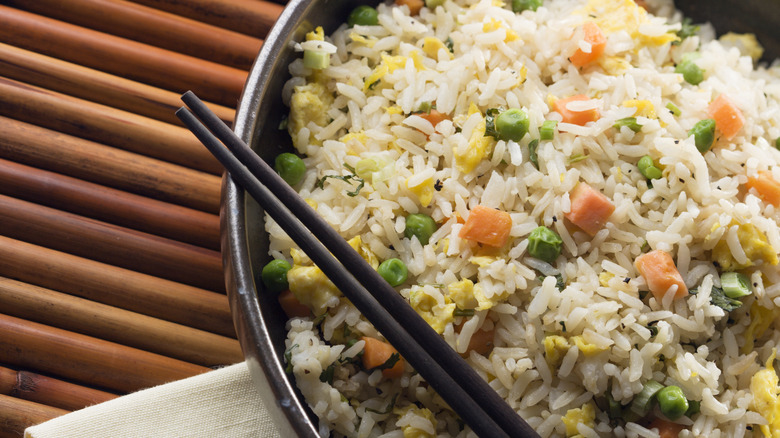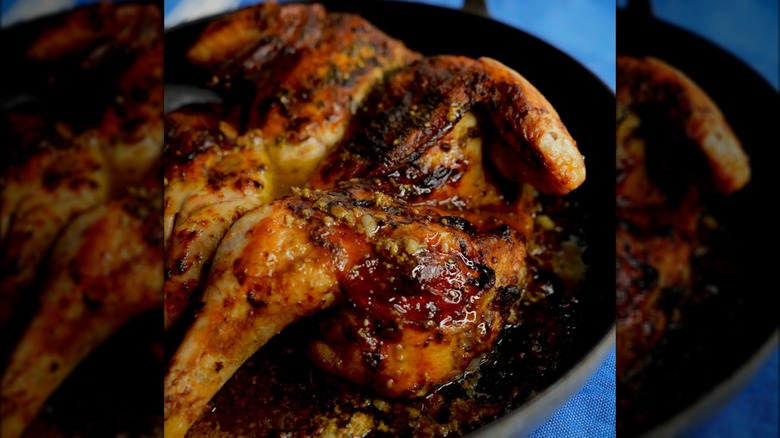Jeremy Scheck Wants To Make Cooking Easy And Accessible - Exclusive Interview
Jeremy Scheck is a culinary internet sensation boasting a combined 2.3 million TikTok and Instagram followers. Fans of Scheck's thoughtful and accessible videos can now replicate the creator and cookbook author's recipes at home with "ScheckEats — Cooking Smarter: Friendly Recipes with a Side of Science". Scheck is a graduate of Cornell University, where he studied Food Science, as well as Italian and Spanish. His diverse knowledge of different cultures and culinary practices is on display in his considered guide for home cooks looking for straightforward but flavorful recipes that can primarily made with staple ingredients already in their pantry.
We recently chatted with Jeremy Scheck to learn about some of his favorite cooking tips and how he's translated his digital content into a compelling, resourceful, and easy-to-use cookbook. Speaking exclusively with Tasting Table, Scheck shares his favorite spices to use in the kitchen, his hacks for reducing cooking time, and the two underrated ingredients he wants you to start using.
Tips for cooks who are new to the kitchen
Many of the recipes in "ScheckEats ― Cooking Smarter" and on your TikTok channel are geared toward making cooking enjoyable and accessible for home cooks. What are some of your favorite tips for those who are new to the kitchen?
I actually have a page in the book with eight quick tips. These are the really broad tips. [For instance], make sure that you salt at every stage, instead of just salting at the end, because [the dish] will have a different flavor and you might end up not needing as much salt if you do it in layers. Don't be afraid of high heat. A lot of new cooks are really scared about burning things, which is understandable. At the end of the day, you need high heat to get a good sear and that caramelization or Maillard reaction — it's [key to the] flavor. If you don't use high heat, you're going to get a lot of sad, gray-looking proteins or mushy vegetables.
What's a dish that you've found to be a crowd-pleaser that's actually fairly simple to make?
The cover recipe of ["ScheckEats — Cooking Smarter"] is my Date Butter Roasted Chicken Thighs. It's an all-in-one pan recipe, [which is] super easy to make. I personally believe that it's pretty stunning. For all of the recipes in this book, there's a really low barrier to entry. They only use staple ingredients and then, [either] a protein or a couple of other vegetables — those may not be things that you always have on hand, [but each recipe] only has a couple of additional ingredients, so you never have to shop for 10 things to make one [dish]. If you have the staple ingredients, you can make pretty much everything, either with just the staples, or with one [to] three other ingredients.
Staple ingredients for everyday cooking
What are the staple ingredients that you always keep in your pantry?
I have a whole page on [staple ingredients] in the book and several pages dedicated to an in-depth explanation of each ingredient. You might not think you want an explanation for flour or balsamic vinegar, but there are a lot of things that people might not know. For example, I don't think a lot of Americans realize that balsamic vinegar is made from grapes. That's maybe more obvious in Italy, and that's interesting.
[For a staple ingredient], you don't need to buy the most expensive 12-year-aged balsamic vinegar. I try not to make my recipes super expensive or difficult to source, and the average grocery store in the US is not necessarily going to have that. I include instructions in case you have the aged balsamic. It's going to be sweeter than if you get the standard [balsamic] that's available, so I give tips on how and when to use it.
What are your favorite spices to utilize in the kitchen?
I have 10 spices that I use throughout ["ScheckEats—Cooking Smarter"]. We're actually going to sell a bundle of the spices, with a brand called Gneiss Spice. They have these little jars that can stick to your fridge — they're magnetic and they're glass. [Gneiss Spice] can also ship you refill spices, with compostable bags, so it's very low waste.
All the recipes in the book can be made with just the 10 spices: Herbes de Provence, black pepper, oregano, sweet paprika, cumin, Za'atar, garlic powder, ground cinnamon, red pepper flakes, and sesame seeds. You might not necessarily think, "I'm going to use Za'atar in all my cooking," but I give you a lot of recipes to use it. Any time I ask for a [special ingredient], I'm going to give you multiple things [to use it for], because my pet peeve is when you're asked to buy a certain ingredient for a recipe, and then you're stuck with half of the bottle or jar afterward, because you don't know how to use the rest of it.
Scheck's underrated cooking ingredients
What is your favorite underrated cooking ingredient?
I have to pick two, and the two that I'll pick are pomegranate molasses and Calabrian chili paste. Pomegranate molasses is really popular in Middle Eastern and, especially, Persian cuisine. It's basically concentrated pomegranate juice. Sometimes, it might have a little bit of added sugar or lemon juice, but it's basically the texture of a balsamic glaze, with a pretty sour and a little bit of sweet pomegranate flavor. It is such a versatile ingredient. You could also use it in cocktails.
I have a Pomegranate Molasses Glazed Salmon recipe. I include it as a generic marinade. There's a whole page [in the book] on marinades. I use [pomegranate molasses] in a salad dressing. It goes with literally everything, because you always need something a little bit sour to lighten things up and to have that acidity and balance. It's one of my favorite ingredients.
Pomegranate molasses and Calabrian chili paste are a little bit more difficult to find than pretty much every [other ingredient I mention in the book], which [are all] very easy [to locate]. They sell Calabrian chili paste at Trader Joe's, and they have pomegranate molasses at Whole Foods. You can buy them online, or you can buy them at Wegmans. Any kind of Middle Eastern grocery store [will carry pomegranate molasses], as well, so it's not impossible to find. I give you a lot of recipes to use both of them.
Calabrian chili paste is fermented. I love putting it [in eggs]. I have a really simple fried egg in Calabrian chili butter recipe, as one of the breakfasts [in the book]. I love putting Calabrian chili paste in a balsamic vinaigrette and making a sweet and spicy salad dressing. I like to add [Calabrian chili] paste into braises, for a little bit of heat and funk. Both of those are really versatile ingredients on opposite ends of the spectrum. One's kind of sweet and sour, and the other one is funky and spicy and a little sour.
How to shop thoughtfully at the grocery store
What are your favorite tips for how to shop economically at the grocery store?
I really wanted the staple ingredients and recipes in the book to mirror how I shop, so I think of the staple ingredients as the things that I always have on hand. If I ran out of them, I would replace them, always. If I run out of olive oil, I'm going to replace it, no matter what. If I run out of soy sauce, I'm going to replace it, no matter what. Then, I think of the remaining ingredient or ingredients in certain recipes, whether they are produce or proteins, as the "star ingredient."
The way I personally shop is, "What staples am I out of?" And then, "What looks good? What's on offer? What's in season?" A typical shopping [trip], for me, would be replacing a couple of staples that I might be out of and then looking for three star vegetables and maybe two star proteins — whether it's a piece of meat that looks good, or tofu, or anything that catches my eye, or that might be in season. I love to do that, especially at the farmer's market. If you have one near you, that's a great way to source star ingredients.
For all of the recipes in ["ScheckEats -- Cooking Smarter"], the recipe will say, "All staple ingredients" [if the recipe only requires staples], and then in the corner, it will say, "Gluten-free or vegetarian" [if the recipe fits a particular diet]. If [a recipe] has an additional ingredient, it will be highlighted in yellow in the ingredients list, so you can quickly scan the recipe and say, "What would be a staple, and what would I actually need to separately buy?"
Best practices for cooking with wine
You often utilize wine in your recipes. What are some tips you have for home cooks working with wine, maybe for the first time?
I love wine in cooking, because I love that it brings brightness and a depth of flavor. White wine, especially, is one of my staple ingredients. I also really like red wine for braising. I usually say that I prefer to get a dry white wine, as a general rule. It's similar to choosing to buy unsalted butter — you can always add [more salt later], but it's harder to take away, so I prefer [to use] a dry white wine, [which is less sweet]. I like something that's good enough to drink, but it doesn't have to be expensive. You can spend $10.00 on it. It doesn't have to be much more expensive than that. In my opinion, you don't want to cook with a wine that you wouldn't drink on your own.
Do you have any alcohol-free ingredient swaps for folks who don't drink wine?
That's a question I get asked often. A lot of people don't keep alcohol in the house for [personal] or religious reasons. The best substitute for wine is verjus, in my opinion, which is an alcohol-free grape juice that's less sweet. In a pinch, you can always use chicken stock and a little bit of lemon juice to get that depth of flavor and acidity.
Handy tips for reducing cooking time
Do you have any general recommendations for how to cut down on cooking time?
In ["ScheckEats -- Cooking Smarter"] I talk about convection ovens and the science of convection ovens. For simplicity, usually, people reduce the temperature of a convection oven to match the temperature of what a non-convection oven would be. There's also a way to use a convection oven at the intended or original temperature and to cook [the dish] for less time.
There are a lot of quick recipes in the book, especially a lot of the pasta recipes where the sauce comes together at the same time that it takes to boil the pasta, like my Aglio E Olio. I also like recipes that might not be as quick, but that have a lot of inactive time — [for example,] making chicken soup or braising. Once you do the initial prep, it might cook for eight hours, but you don't have to do anything [during that time]. I try not to rush it. [In the book], I try to have a mix of quick recipes and ones that might require a little bit more love.
Creamy pasta sauce without cream
Can you provide any guidance on preparing rich and creamy pasta sauce?
One thing a lot of Americans don't do when cooking pasta is a step called "Mantecatura" in Italian. Basically, that describes the combining of the cooked pasta with the sauce, in the final step, and mixing it really vigorously — marrying the sauce with the pasta. It makes a really big difference. It makes the pasta a lot creamier. A lot of times, they'll describe the sauce as a cremina, which is the diminutive for cream. When you do a mantecatura, it's like you go from having a separate sauce to something that is creamy, despite not using cream.
[Heavy cream] isn't a super common ingredient in Italy for pasta sauces. Most of the pasta dishes [in the book] don't have heavy cream in them, but grated cheese and olive oil or butter mixed with the starch of the pasta create the texture of the mantecatura. That's why I always advocate for mixing the pasta, instead of making a sauce separately and cooking the plain pasta and putting it on your plate like that. My grandma illustrated the whole book, and I have a little illustration of the difference [between those two pasta sauce methods] in it.
The best meal to make with leftovers
What is your favorite meal to make with leftovers?
Fried rice. I make it all the time. A lot of times, if I order Chinese takeout, I'll order an extra container of rice, for the purpose of having it for fried rice. To me, it hits all of the notes and you can pack it with protein and veggies. You might not necessarily think of [fried rice] as a health food, but it's fairly nutritious. You can have carbs, you can have veggies, you can have proteins. You can have egg and meat or just egg. There are so many things that you can do with it. For me, [fried rice] is a go-to, especially when I was in college.
What flavors, seasonings, or sauces do you add to your fried recipe before including protein and veggies?
I usually like to start with some sort of allium. I'll either do onion or garlic. I don't usually do both of them. Sometimes, I like to go for the more hibachi style, like butter and garlic — it's really good. Then, I'll add the leftover cold rice. It's important that it's leftover, because it will be less sticky. Then, I like to add frozen vegetables. [Frozen vegetables] are something that you can always have available to you. Then, I move them over in the pan and add eggs. Some people like to add the eggs beforehand, but I don't really want to dirty another plate by taking things out and putting them back in. For seasonings, I usually add a little bit of MSG. Then, I add soy sauce or tamari. Sometimes, depending on my mood, I'll add a chili garlic paste, and usually a little bit of oyster sauce. Sometimes, I add a little bit of dark soy sauce. I always say, "I make it differently every time I make it."
Making simple and delicious roast chicken
What is your secret for preparing weeknight roast chicken?
I have a whole roast chicken section in ["ScheckEats — Cooking Smarter"]. One secret is to cook the chicken on high heat, salted, with nothing on it for the first 30 minutes. Then, take it out of the oven, season it, and add a dry rub. I have multiple options in the book [for roast chicken]. One is a yogurt and Za'atar marinade. One is my mom's spice rub. I have a maple, butter, and garlic situation.
I like to add a little bit of sweetness to a roast chicken, whether it's brown sugar or maple. It brings out the savoriness and balances everything really well, but [those do] have a tendency to burn. If you start [the chicken] on high heat and cook it halfway with just salt and let everything get crispy, then you can lower the heat and add everything else to season it. That's a method I use in the book that is a foolproof way to avoid burning while also getting all the flavors.
Super-fast crowd-pleasing desserts
Can you share the inspiration behind your pretzel blondies and any other sweet treats that you love?
The pretzel blondies don't have the sweetest inspiration. They're a dessert I tend to make when I agree to cook something and then don't really have time, because they take so little time to make. Compared to scooping out individual cookies, it takes about five minutes to put the batter together for [pretzel blondies]. They bake in the oven for around 20 minutes, and then that's it.
There are a lot of chocolate chips happening in the dessert section of ["ScheckEats — Cooking Smarter"] because I focused on classic recipes. I tried to think about them in different ways, whether it's tying in the food science or tying in some sort of update or refresh to them. There are two chocolate chip cookie recipes, a brown butter recipe, and a more bakery-style large chocolate chip cookie recipe, and then the pretzel blondies. It's a little bit repetitive, but that's on purpose to show that there are different ways that you can make something similar, depending on what you are hoping for and what your needs are.
"ScheckEats — Cooking Smarter" is now available for purchase here. Keep up with all things Jeremy Scheck and ScheckEats on Instagram and TikTok.
This interview has been edited for clarity.
